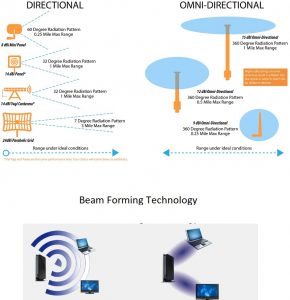What Antennas Easy Wireless Bounce Off of for Their Phone Service
WiFi antennas Vs Cell Phone signal booster antennas
The "cutting the cord" movement has been gaining momentum in the recent years and slowly taking shape to become a phenom! Why are people reacting to it with such enthusiasm is for very obvious when you look at the numbers. 2018 is touted to the year the movement is going to gather the critical mass it requires to start a snowball effect. Sling TV has over 2 million subscribers and HULU, Youtube TV and number of subscribers who exclusively use ROKU and Amazon FireTV is all adding to the pot making this piece of the pie grow larger every day. The millennial generation that never had cable are not even included as "cord-cutters", they are the "cord never's" bunch that is helping propels this generational shift in how TV content is consumed.
With this shift, came the need for stronger WiFi routers that power this idea of "cutting the cord" wanting more powerful WiFi signal that covers a wider area inside the house. WiFi signal was just supporting the laptops and cell phones in the past, if the router is in the living room and if you are not happy with the strength of your connection in the basement, you could just move closer to it in the living room. Albeit an inconvenience, it wasn't enough to justify spending $100's of dollars more to solve it. Now-a-days the router is powering the TV box, the video game box in your kids room, the refrigerator in the kitchen that is hooked to the Alexa box in the guest room, etc. Almost all your devices are getting smarter and wants to talk to each other, seems like the way things are heading.
When 802.11n communication protocol for WiFi signal was rolled out back in 2010 as an upgrade to the then legacy 802.11a/b/g wireless standards it was a major upgrade and 10x faster to the then speeds. The technology also envisioned the way IoT (Internet of Things) was shaping up and the technology took into account the future need for stronger and more importantly a focused beaming of WiFi signal to devices that needed it by cutting on broadcasting Wifi signal where it was not needed. The "beam forming" technology was the answer directly taking ques from the cell phone signal transmission methods. The cell phone signal boosters typically used 2 types of signal broadcasting and receiving with a Omni directional antenna or a directional Yagi antenna. With the beam forming technology the router acted just like a Yagi antenna that only broadcast signal in a particular direction or only to the device that it was paired. However that did not work like it was envisioned back then, because the device manufacturers were slow to catch on to this feature and they did not have a standard to adhere and were all not on the same page.

When 802.11ac standards of wireless communication rolled out in the recent years, that feature was taken advantage of and the device manufactures were able to finally deliver what was required. As you can see in the above illustration that the beam forming technology targets the devices and communicate in sync with the device as both the wireless router and the devices are talking to each other and bond with a strong connection instead of just capturing a portion of the signal like in the past when the router broadcast its signal all round like an Omni directional antenna does. By focusing the signal in specific direction the wifi routers are able to broadcast signal further and stronger.
christensenaladvid.blogspot.com
Source: https://cellphoneboosterstore.com/tech-news-and-blog/wifi-antennas-vs-cell-phone-signal-booster-antennas/
0 Response to "What Antennas Easy Wireless Bounce Off of for Their Phone Service"
Post a Comment